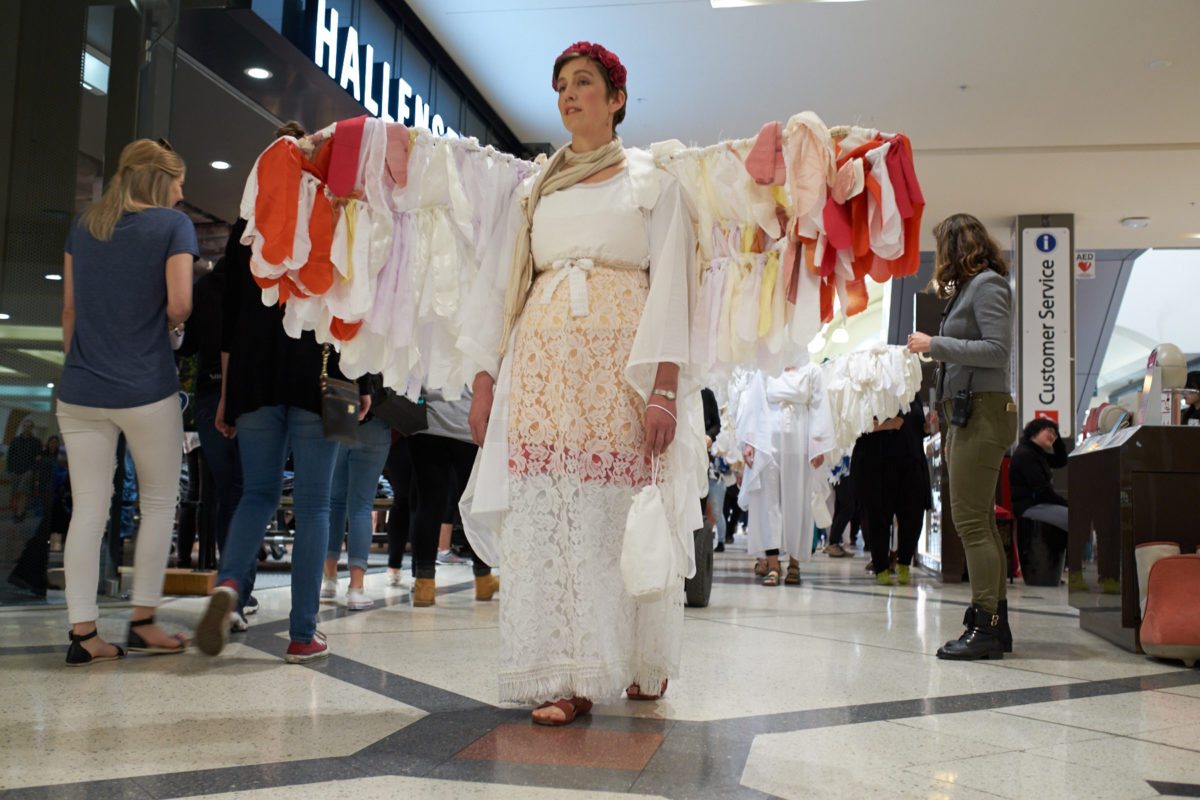By Lucette Hindin

Between mid 2016 and early 2017, I worked as a volunteer with 350.org, an international environmental group that encourages institutions to divest from fossil fuels. I led the Earth Guardians Otautahi1 project, which involved creating six angel costumes and appearing as silent messengers, witnesses, and kaitiaki2.
By Lucette Hindin

Between mid 2016 and early 2017, I worked as a volunteer with 350.org, an international environmental group that encourages institutions to divest from fossil fuels. I led the Earth Guardians Otautahi1 project, which involved creating six angel costumes and appearing as silent messengers, witnesses, and kaitiaki2. In Australia, I followed the lead of the angel clad Climate Guardians, who describe themselves as a movement to urge care for the precious natural world to protect children and future generations from the imminent threat of climate change.
My third appearance as an Earth Guardian was at The People's Climate Rally in New Plymouth, in the North Island of Aotearoa3, New Zealand, as part of a non-violent direct action aimed at disrupting the oil industry's annual conference. At Owae marae4 in Waitara, we were told stories of Parihaka5 and were welcomed as supporters in the tangata whenua’s6 long struggle to protect the land from exploitation and regain sovereignty.
When my teacher, Sister Pho Nghiem, at Dharma Gaia in Coromandel asked if I could carry her name on a feather, this idea birthed a beautiful deepening of the project and its purpose.
I offered the same opportunity to others via text message, email, Facebook, and in person. I asked my friends and colleagues whether they would like to come with me to the rally by having their name written on one of my feathers. Within minutes of the first text message, a dozen people had responded, “Yes.” They wanted their name, their children's names and, in one case, their dog's name on a feather. Eventually, I had around a hundred people's names flying in my wings.
Wherever I went as an angel, I also went as a Sangha body. I was not alone in expressing my beliefs and values. A lot of people who were not prepared to travel to New Plymouth and put their bodies in a blockade on a rainy day took one step closer to being involved in some kind of action to combat climate change. One hundred people who wished they could do more to help were able to join my journey of hope as feathers and share my vision of a better future.
Many people at present are on the edge of taking environmental action. They are aware of and concerned about climate change, but they are unsure how to respond. They may fear that involvement will mean lifting the lid on difficult emotions. The angels offer a different way of engagement to keep joy, creativity, and beauty alive in the face of our fear and grief as we stand up for what we care about.
Being also present at protests and actions as an all-loving and benevolent human helps strengthen and support the kaupapa7 of nonviolence, which means not watering the seeds of anger or violence in myself or in any other person.
Our concerns for the environment, for nature, for our own habitat, and for our children's futures must be lived collectively, shared, and acted on in groups. Thay's prediction that “the next buddha will be a Sangha” seems particularly relevant at this time. The most important thing we can do to bring about change is to create a mass movement. Once it is clear that a majority of citizens want to change to renewable energy and transport, to keep fossil fuels in the ground, and to de-industrialise farming, then these things will begin to happen at a much faster pace. Acting together fosters hope, joy, belonging, and strength.
1 Otautahi is the Maori name for Christchurch, the city where I live.
2 Kaitiaki is a guardian of the natural world.
3 Aotearoa is the Maori name for New Zealand.
4 A marae is a meeting house with associated buildings, the center of Maori communal life.
5 Parihaka is a village where the community practiced nonviolent protest during the unlawful land confiscations in the mid to late 1800s.
6 Tangata whenua, “people of the land” is a way of referring to Maori people.
7 Kaupapa refers to the culture, values, and principles that inform the choices and action of a group.
THIS ARTICLE WAS ORIGINALLY PUBLISHED IN EARTH HOLDER SANGHA’S NEWSLETTER (ISSUE 11, FALL 2017; EARTHHOLDER.ORG/NEWSLETTER), AND HAS BEEN REPRINTED WITH PERMISSION.

Lucette Hindin, Unfurling Koru of the Heart, lives in Lyttelton, Aotearoa, New Zealand. She promotes sustainability, waste reduction and environmental awareness through a local community development nonprofit organization. She is also part of Our Climate Declaration, a grassroots movement aimed to educate and inspire people to take action on climate change.

